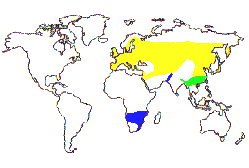
Puddles
The Raptor Foundation
 Puddles The Raptor Foundation |
| Length | 30-36cm | 12-14" |
|---|---|---|
| Wingspan | 82-92cm | 32-36" |
| Weight | 130-340g | 4-12oz |
The Northern Hobby, or just Hobby, is similar in size to kestrel, but has a shorter tail & long sickle-shaped wings.
It is thought that the English name may be derived from the Old Dutch "hobben", meaning to move up & down or side to side (cf. Hobby-horse), possibly due to its acrobatic flying ability.
The Hobby is found throughout Eurasia, as far north as southern Scandinavia & as far East as China. The European population is migratory, wintering mainly in Africa.

The Hobby is mainly a summer visitor to UK, coming here between late April & late August and returning to Africa in winter. In the first half of the 20th century the population was around 60-90 pairs in 1950's, this has risen substantially to an estimated 500-1000 pairs in 1990's, mainly in southern England, some have been seen as far north as Yorkshire. Currently, there are seen to be no specific significant threats to the Hobby. The Hobby is a species protected by special penalties in the UK, if kept in captivity, it must be ringed & registered.
The Hobby preys mainly on large flying insects, such as dragonflies & termites. During the breeding season, when the male is feeding its mate & young, it will prey on small birds, such as swifts & swallows. In pursuit of the fast flying birds, it will use both stooping & low-level surprise attacks to catch birds in mid-air. They are capable of flying very fast, outflying swifts at speeds estimated to up to 100 mph. In addition to flying fast, they are capable of impressive aerial acrobatics. Very rarely they will feed on small mammals & invertebrates. Still-hunting may be used to catch mammals. They have also been observed to steal food from kestrels & also to walk around the ground in search of earthworms.
The Hobby usually breeds for the first time at two years old. They will usually nest in old crows nests, often in fir trees. Egg-laying is often in June, with around 3 eggs laid. Incubation takes around 28-31 days. The young are fully fledged in 4-5 weeks & fully independent between 4-6 weeks later. The young are often lost to crows nesting in the area.
The oldest Hobby on record from a European ringing study was 14yrs 1month old, and dead from botulism rather than natural causes.
In 1947 when the British patent office refused to let Peter Adolph patent a new game as "The Hobby", being a keen ornithologist whose favourite bird happened to be the hobby, he successfully patented the game as "Subbuteo". The head of a hobby has been used as a logo on all Subbuteo products & on the crest of most Subbuteo clubs.
Robin : Male
Least Concern (LC)
| English |
| ||
|---|---|---|---|
| Welsh |
| ||
| Scottish |
Gormag | ||
| Irish |
| ||
| Catalan |
Falcó mostatxut | ||
| Danish |
Lærkefalk | ||
| Dutch |
Boomvalk | ||
| Esperanto |
Alaûdfalko | ||
| Estonian |
Lõopistrik | ||
| Færoese |
Vákasmyril | ||
| Finnish |
Nuolihaukka | ||
| French |
Faucon Hobereau | ||
| German |
Baumfalke (Tree Falcon) | ||
| Hungarian |
Kabasólyom | ||
| Icelandic |
Gunnfálki | ||
| Italian |
Lodolaio | ||
| Latvian |
| ||
| Lithuanian |
Sketsakalis | ||
| Norwegian |
Lerkefalk | ||
| Polish |
Kobuz | ||
| Portuguese |
Ógea | ||
| Russian |
Чеглок (Cheglok) | ||
| Spanish |
| ||
| Swedish |
Lärkfalk |